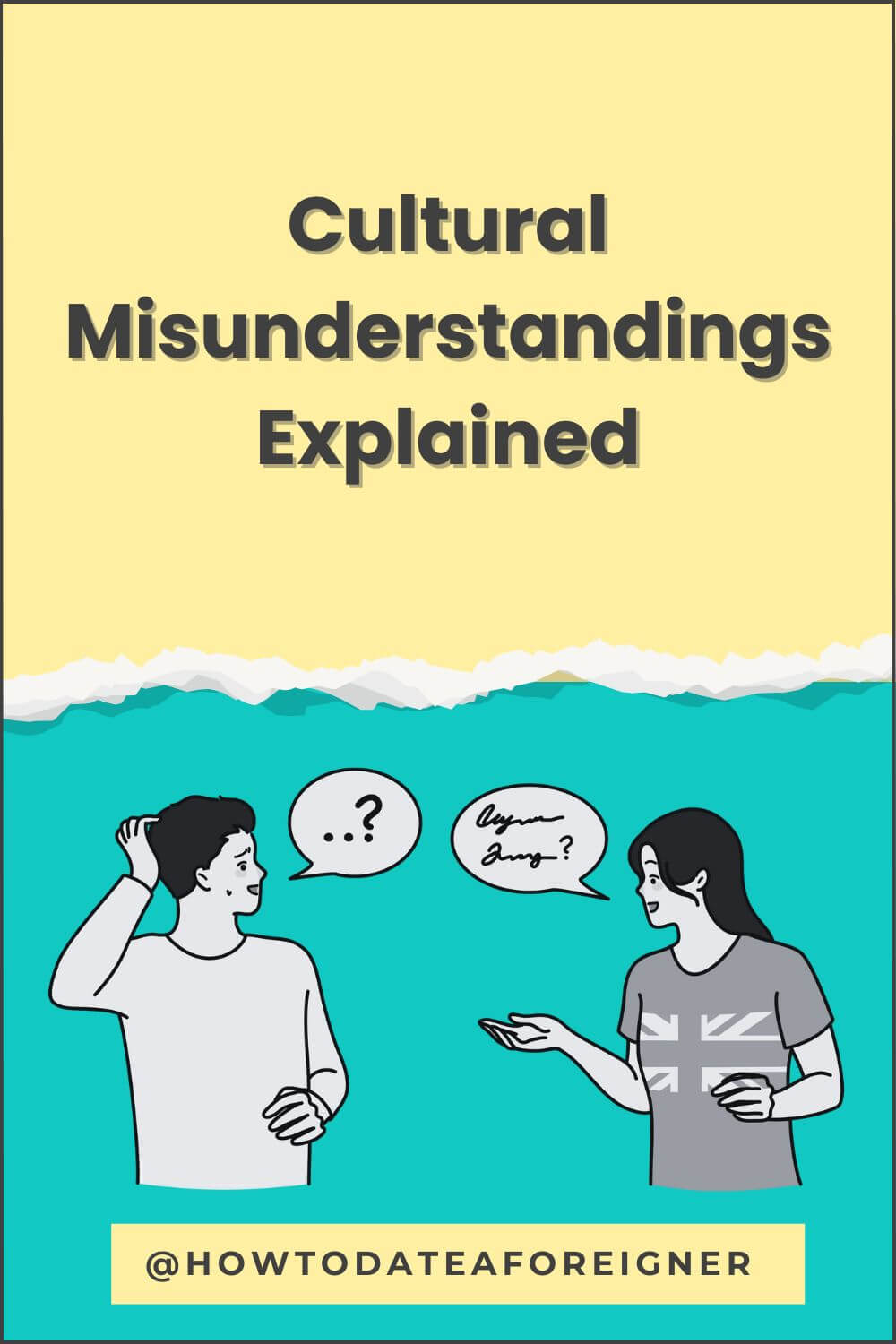
Summary: In this article at How to Date a Foreigner, we will take you through the 4 types of cultural misunderstanding examples with many real life scenarios. Any misunderstanding you might encounter will usually fall into one of these categories. Even though it is hard to identify them when you don’t know someone’s culture, it will help you to know which direction to look.
What is cultural misunderstanding?
Cultural misunderstanding happens when two or more people speak the same language, but they mean or understand different things.
This is usually due to their cultural background and experiences.
We often don’t realize how much our experiences shape our understanding of words. We have divided them into 4 types and will take you though each of them with an example.
4 Types of cultural misunderstanding (examples):
1. Language based misunderstanding
Language based cultural misunderstanding happens when you have a different understanding of the same word / expression. One person’s experience (and often even feelings associated with a word) are different than the other’s, despite using the same word. Let’s look at a few examples:
Example 1: Britt vs. Dutch
A popular one is the Anglo-Dutch Translation Guide that has been circulating the internet in different forms:
Example 2: ‘How do you Date?’
Another one, that was actually a personal experience of mine several years ago was when I just started researching dating cultures.
I asked my Vietnamese friend ‘How do you date?’. We were well into our 2 hours long discussion when we realized our understanding of the word ‘dating’ is different!
Her culture has a clear separation between the dating phase and the relationship phase. So for her, dating was everything that happens prior to a relationship.
However for me, in my culture, the dating phase gradually becomes a relationship. There is no clear separation. So for me, dating meant the same thing as a relationship.
Example 3: Vulnerable
I had a few other surprising experiences with language based cultural misunderstandings. You can read my other surprising story on: Vulnerable Meaning and My Personal Experience
2. Behavior based cultural misunderstanding examples
Example 1: Yes or No?
Behavior-based cultural misunderstanding happens when one person acts in a way that means a different thing to the other.
Maybe you are used to people acting a certain way in your culture, but this person acts contradictory to how you are used to it.
Example 2: ‘You Talk too much!’
This is a perfect example for behavior based cultural misunderstanding.
My friend was seeing an American guy and very early on in the relationship, the guy told her she talks too much. They blocked each other back and forth, until eventually they ended up moving in together.
By that time, she was more than comfortable with him, so she didn’t feel like she had to ‘entertain him’ anymore. She went quiet and enjoyed doing her things.
On the other hand, the American guy really wasn’t used to this. His dating culture was the opposite. They talk little in the beginning until they warm up to the other person. So he assumed she had a problem and started really going out of his way to try and make her happy.
Now, she got very confused and started assuming there is a problem and she is a burden for him. So she asked whether she should move out, just to find out, the guy thought she had a problem.
3. Mixed Language & behavior based
The third type sound like the most complex, but it is actually the easiest to detect. This is because you can feel something doesn’t add up. However, as we often don’t question things, it often makes people think the other person is lying.
Mixed language & behavior based misunderstanding often happens when we have the same understanding of the words, but the behavior of the other person makes us not believe what they say.
Example 1: ‘I love you’
A really good example for this is when my Vietnamese friend’s British boyfriend told her he loved her. She told him, she doesn’t believe him. Why was it?
In Vietnamese culture, there are 2 different words for ‘love’. One is used for a person and the other is for everything else. As her British boyfriend used the word ‘love’ for everything (from football to chicken) it lost its meaning for her. It wasn’t as powerful anymore. They used the same language and had the same understanding, but his behavior (using the word) degraded the meaning for her.
You can read the full story here: ‘I love you!’ – Why She Doesn’t Believe You?
Example 2: ‘Negrita!’
I loved reading about Oneika’s experience, a black American girl who traveled to Mexico. Based on her American cultural background, using the ‘N’ word was a NO-NO. Soon after she arrived to Latin America a friend of her called her ‘Negrita’. Understandably she was shocked.
However one of her commenters, Miguel M Miguel, explained:
For good or bad, in Latin America we call each other “negro,” “chino,” “gordo,” “flaco,” “chaparro,” etc. both in Spanish and Portuguese. No one gets offended because is a TERM OF ENDEARMENT. That’s our way to show affection and treat others (friends or not) with warmth and familiarity. We are not insulting anyone, is actually ALL THE OPPOSITE. If you are called Negro or Chino in a friendly manner, is same as being called “buddy,” “mate,” or even “darling.”
Example 3: Dating
Dating can be frustrating on its own, let alone mixed with some cultural misunderstandings.
The more I research dating cultures, the more cultural misunderstanding examples I find between US and Eastern Europe.
A friend of mine had a date with an American guy she really liked. He told her he likes her then disappeared from the face of the Earth. Took ages to reply to messages and his actions screamed he is not interested. Well, at least according to her Eastern European experiences.
In many Eastern European countries, if you had a date with someone and you would like to continue seeing them, you message them you had a great time to let them know you are interested.
However, the total opposite is true in the US. In the US, you are supposed to play mind games and play the ‘cool, not interested’ type. There is even a dating agency called the ‘Three Day Rule’ implying you are not supposed to message for 3 days. Otherwise you will come across as needy.
In Eastern Europe if you don’t message for 3 days, it is likely the other person won’t even speak to you.
If they message you, you need to reply usually within 30-60 mins if you can or if you are super busy, then by the end of the day.
4. Silent Assumption
The last one I feel should be mentioned is the silent, assumption based cultural misunderstanding. Where you don’t talk or behave in a certain way, just assume based on your cultural experience.
Example: Eating out – a Treat or Threat?
One of my close friends, who is in a relationship with a guy from Africa, got a message from her boyfriend to get ready. They are going out (around 9pm).
She was getting a bit hungry, but thought they are going out and automatically assumed they will eat outside. For her, eating out is a treat, but on top they live in a cheap Asian country where many people eat out even 3x a day.
He got home and they ended up in a 1 hour long argument why she didn’t cook and now he will have to go out hungry. Turned out, he automatically assumed they will eat at home before going out. Why?
In his developing country, when he was growing up, he was tought to ALWAYS eat at home. They only eat outside if there is no other option as people could poison their food. So for him, eating at home is standard for security reasons, and could mean saving his life.
When you are in an intercultural relationship, never assume. Always ask. It could save you from unnecessary arguments.
…and talking about food and cultural differences, we just couldn’t close this blog post without a funny video! Enjoy!
Conclusion
If you are going through some differences with your partner, consider that it could be cultural. These types of cultural misunderstandings don’t only happen in personal relationships, but they often happen in business too. You can read some interesting ones here.
We hope you liked this article. If you had a surprising cultural misunderstanding (especially when it comes to international dating), we would love to hear it! Let us know in the comments below.

